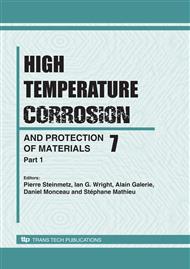p.1075
p.1083
p.1093
p.1103
p.1111
p.1119
p.1127
p.1135
p.1145
Why the Growth Rates of Alumina and Chromia Scales on Thin Specimens Differ from those on Thick Specimens
Abstract:
For a number of chromia and alumina forming high temperature alloys and coatings, recent studies revealed, that in some cases the specimen/component or coating thickness may substantially affect the growth rates of the surface oxides. For the alumina formers the thickness dependence is mainly governed by depletion of oxygen active elements such as Y, Zr, Hf, Mg which are either intentionally added alloying elements or manufacturing related alloy impurities. In the case of the chromia forming materials, which tend to exhibit a more substantial dependence of oxidation rate on specimen/component thickness, depletion of minor alloying additions is also an important factor to be considered. However, for these alloys relaxation of oxide growth stresses by plastic deformation of the metallic substrates seems to be the dominant parameter which governs the observed behaviour.
Info:
Periodical:
Pages:
1111-1118
Citation:
Online since:
September 2008
Keywords:
Price:
Сopyright:
© 2008 Trans Tech Publications Ltd. All Rights Reserved
Share:
Citation:


